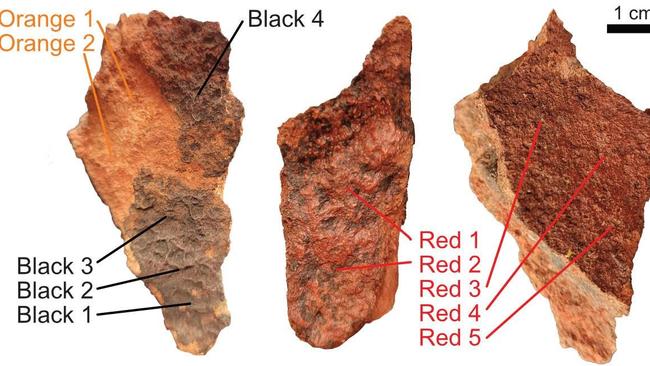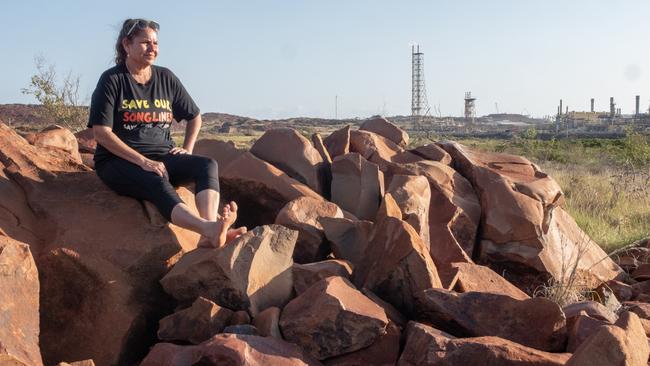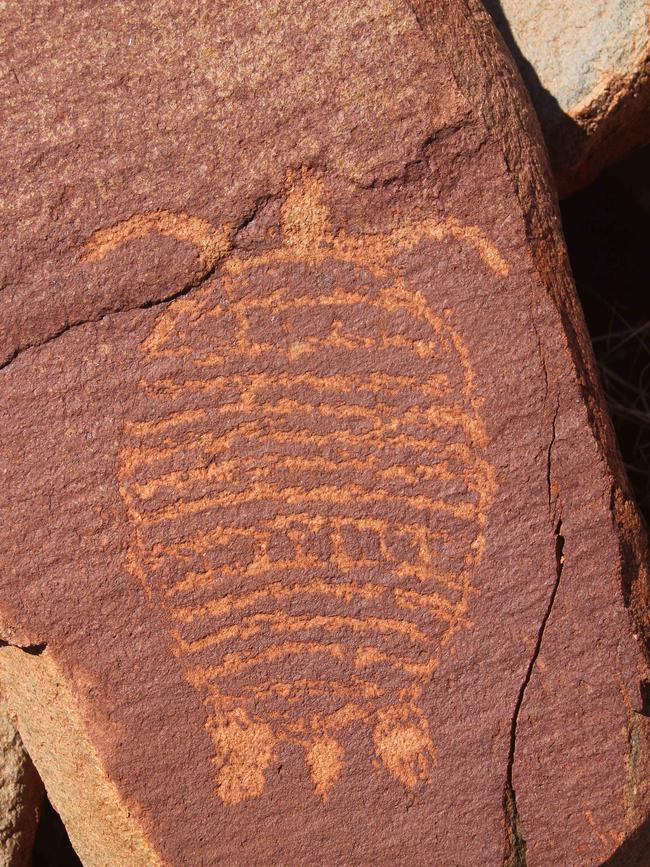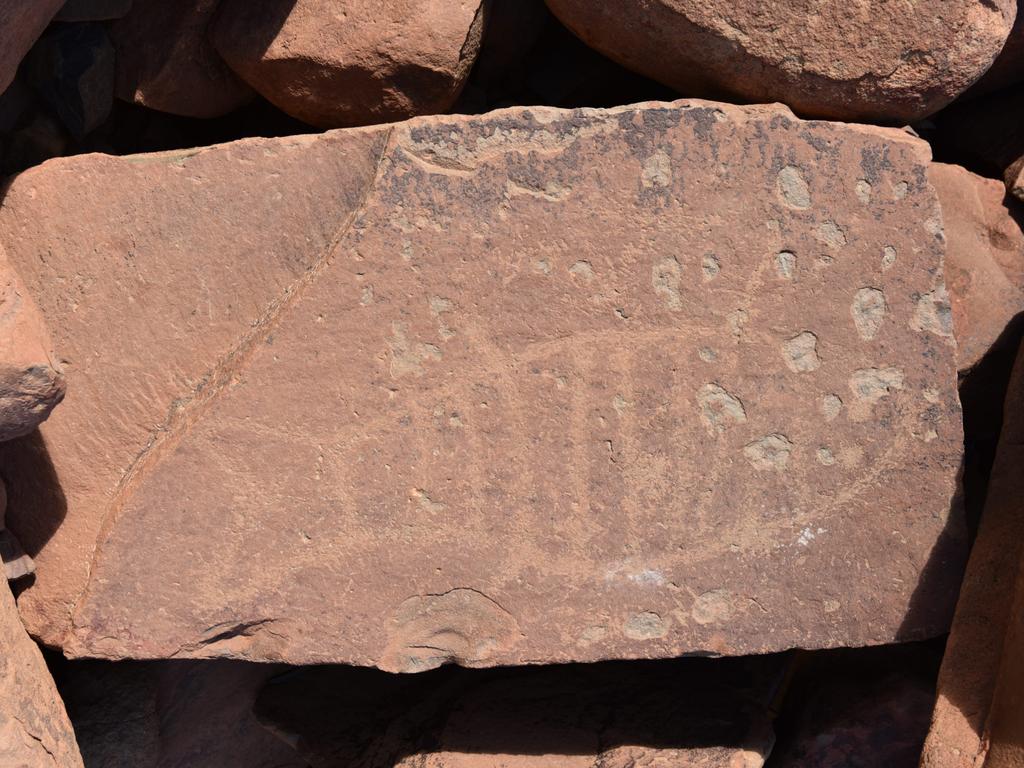Archaeology professor says rock the ‘smoking gun’ that could stop North West Shelf expansion
A small piece of rock that spent 30 years sitting in a Melbourne office will be used in an 11th-hour bid to blow apart the $30bn decades-long extension of Woodside Energy’s North West Shelf gas plant.

A small piece of rock that spent 30 years sitting in a Melbourne office will be used in an 11th-hour bid to blow apart the $30bn decades-long extension of Woodside Energy’s North West Shelf gas plant.
As Anthony Albanese told his newly installed cabinet that gas would be central to his government’s clean-energy revolution, an archaeology professor from the University of Western Australia revealed what he said was the “smoking gun” that shows the gas plant and other heavy industry on WA’s Burrup Peninsula are in fact harming the ancient rock art from the surrounding area.
Environment Minister Murray Watt is just days away from delivering what is expected to be an approval of Woodside’s plans to stretch the life of the North West Shelf facility out to 2070.
The WA government late last week finally released the results of the latest study examining whether emissions from the North West Shelf and other heavy industry on WA’s Burrup Peninsula, or Murujuga, were impacting on the one million-plus pieces of ancient Aboriginal rock art in the area.
A summary of the Murujuga Rock Art Monitoring Program study said its findings showed there was no acid rain in the area, and attributed the negative impact identified on one of five types of rock being studied in the program in one part of the peninsula to a small power station that operated in the area in the 1970s and early ’80s.
But UWA professor of archaeology Benjamin Smith challenged the accuracy of the report’s highlighted findings, and said there was physical proof to debunk the claim that it was the old power plant, rather than current heavy industry, to blame for the increased porosity identified in granophyre, the main rock type that hosts the ancient petroglyphs.
Critically, he pointed to a rock sample taken from the middle of the affected area in 1994 by prominent archaeologist Robert Bednarik – founder of the Australian Rock Art Research Foundation – and which has been stored in his Melbourne office ever since.
That granophyre sample, Professor Smith said, showed no signs of the increased porosity identified in the recently completed study.
That challenged the notion advanced by the latest MRAMP study that it was emissions from the 1970s and early ’80s – before the North West Shelf and other major industrial projects came into production – that were to blame for the detected damage.
The rock was studied in the past six months as part of a recent PhD by Jolam Neumann at Germany’s University of Bonn, which Professor Smith said came to “the very firm conclusion that Murujuga industrial air pollution is damaging and has damaged the rock art of Murujuga”.
He said Professor Bednarik’s rock was “absolutely a smoking gun” to show it was the current heavy industry that was causing the porosity.
“We have analysed that carefully in the labs in Germany and found that that piece of the rock that came from the area that is now highly porous was not porous at all,” he told The Australian.
“Because of that experience, we can say for certain that that porosity has happened post the collection of this rock, so post-1994.”
The revelations are set to be seized upon by the coalition of environmentalists, current and former politicians and Indigenous activists actively campaigning for the Albanese government to knock back the North West Shelf proposal.
Those groups have previously cited Professor Smith’s work in arguing for the rejection of Woodside’s plans and are planning more action against the project this week, starting with a protest outside the WA parliament on Tuesday. Indigenous activist Raelene Cooper has also launched legal action against Senator Watt in the Federal Court.

Opponents to the project will argue that the findings should at least give Mr Watt reason to pause his decision while he assesses the implications of Prof Smith’s claims.
Professor Smith said the detail in the MRAMP report showed that a statistically significant proportion of the granophyre rock around the region’s heavy industry had become porous.
“This is much more serious than they acknowledge. It is the beginning of the breakdown of the surface due to the industrial emissions,” he said.
Controlled experiments exposing rock samples to pollutants within a weather chamber had also supported the findings of similar experiments Professor Smith had been part of.
Professor Smith, who has written a number of papers highlighting risk posed by industry to the Burrup’s rock art, said the report’s summary also played down the significance of the type of rock the study found had been affected by emissions.
While the summary described granophyre as one of five rock types being studied, he said it was far more significant as it hosts around 70 per cent of the rock art pieces around Murujuga.
Professor Smith said the report’s decision to point to the old power station as the source of the damaging emissions went beyond the study’s remit. He said the study was only supposed to consider whether industrial activity was affecting the rock art, not which specific source was responsible.
The report’s attribution of blame to the old power station did not stack up, he said, given the size and use of the plant. He said the station was only supporting around 400 homes in Dampier and a few hundred homes in Karratha, and never came close to operating at its full capacity.
Professor Smith estimated the power plant would have produced at most one-third of the sulphur dioxide and nitrogen dioxide emissions currently emitted by heavy industry on the Burrup Peninsula.
“They’re trying to pin the blame on the old power plant, which is nice but it’s wrong,” he said.

Senator Watt will decide by the end of this week whether to sign off on an extension of the North West Shelf’s operating life out to 2070. Woodside’s proposal has long been a lightning rod for environmentalists and Indigenous activists concerned about the plant’s potential impact on climate change, endangered species and the enormous amount of rock art in the surrounding area.
The minister was in Perth last week, where he met with WA Premier Roger Cook. Mr Albanese on Monday said his entire cabinet would travel to the state next week.
The Prime Minister on Monday flagged that gas would continue to have an important role in his government’s clean-energy revolution, and would play a key role in “firming” up energy grids during lulls in renewable energy generation.
“You can’t have renewables unless you have firming capacity. Simple as that,” he said.
“You don’t change a transition through, you know, warm thoughts. You do it through a concrete proposal, which is the expansion of renewables up to 82 per cent of the grid. But the way that that occurs is it needs firming capacity to occur.”
Mr Cook on Monday said he was happy with the findings from the latest MRAMP report and reiterated his hope that the North West Shelf extension would be approved.
“(The MRAMP report) is an important report because what it does is provide a community with confidence that the current industrial processes and processing that you see on the Burrup have not had an impact in relation to the rock art and that rock art remains in place,” Mr Cook said.
“What it did point to was some industrial developments or processing, I think it was a power generator that was placed there in the 1970s, which may have had impact in relation to the porosity of some of the rock art. But it’s very pleasing that no ongoing impact has resulted from that industrial activity.”








To join the conversation, please log in. Don't have an account? Register
Join the conversation, you are commenting as Logout